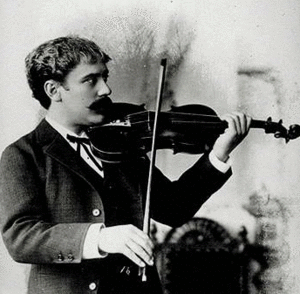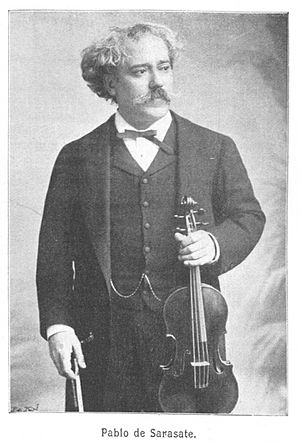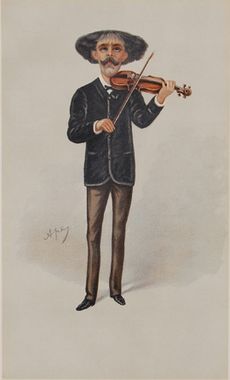Pablo de Sarasate facts for kids
Quick facts for kids
Pablo de Sarasate
|
|
|---|---|

Pablo de Sarasate
|
|
| Background information | |
| Birth name | Pablo Martín Melitón de Sarasate y Navascués |
| Born | 10 March 1844 Pamplona, Spanish Empire |
| Died | 20 September 1908 (aged 64) Biarritz, France |
| Genres | Classical, Romantic |
| Occupation(s) | Violinist, composer, conductor |
| Years active | 1852–1904 |
Pablo Martín Melitón de Sarasate y Navascués (born March 10, 1844 – died September 20, 1908) was a famous Spanish violin player, composer, and conductor. He lived during the Romantic period, a time when music often expressed strong feelings. People usually called him Pablo de Sarasate.
He was known for being a "virtuoso," which means he was incredibly skilled at playing the violin. Some of his most famous pieces include Zigeunerweisen (which means Gypsy Airs), his Spanish Dances, and the Carmen Fantasy.
Biography
Pablo Sarasate was born in Pamplona, Navarre, Spain, in 1844. His father, Don Miguel Sarasate, was a bandmaster. Pablo started playing the violin with his father when he was just five years old. People quickly noticed his amazing musical talent. He gave his first public concert when he was only eight.
His performance was very popular. A rich supporter heard him play and offered to pay for his music lessons. So, Pablo went to study in Madrid. There, he even gained the support of Queen Isabella II. As he got older and better, his parents decided to send him to the Paris Conservatoire. This was a very famous music school. He was only twelve years old when he went.
On the train ride to Paris, his mother, who was with him, sadly passed away suddenly. Pablo also became very ill with cholera. The Spanish consul in Bayonne helped him get better. He then paid for Pablo's trip to Paris.
In Paris, Pablo successfully tried out for the famous teacher Jean-Delphin Alard. At seventeen, Sarasate entered a big competition. He won the "Premier Prix," which was the highest honor at the Conservatoire.
Sarasate had been performing since he was a child. He made his official debut as a concert violinist in Paris in 1860. The next year, he played in London. Throughout his career, he traveled all over the world. He performed in Europe, North America, and South America.
People loved his playing because his sound was very pure. He played with great skill and ease, making him a true virtuoso. Early in his career, Sarasate often played pieces based on operas. His Carmen Fantasy was one of his most popular.
Many composers were inspired by Sarasate's Spanish style. For example, Édouard Lalo dedicated his Symphonie espagnole to Sarasate. Camille Saint-Saëns wrote his Introduction and Rondo Capriccioso especially for Sarasate.
The famous writer and music critic George Bernard Shaw admired Sarasate greatly. He said that Sarasate's playing and compositions were so good, they left critics amazed. Sarasate's own music was often designed to show off his incredible violin skills.
His most famous work is Zigeunerweisen (1878). This piece is for violin and orchestra. Another popular piece is the Carmen Fantasy (1883). It uses well-known tunes from Georges Bizet's opera Carmen. His Spanish Dances are also very popular. These are short, lively pieces that show off the performer's talent. He also arranged music by other composers for the violin.
In Brussels, he met Berthe Marx, a pianist. She traveled with him on his tours. She played in about 600 concerts as his accompanist. She also arranged his Spanish Dances for the piano. In 1904, he made a few recordings of his playing. Even with all his travels, Sarasate returned to Pamplona every year. He loved to be there for the San Fermín festival.
Pablo de Sarasate passed away in Biarritz, France, on September 20, 1908. He had a long-term illness called chronic bronchitis. He left his special violin to a music museum. This violin was made by the famous maker Antonio Stradivari in 1724. It is now called the Sarasate Stradivarius in his honor. His second Stradivari violin is now at the Real Conservatorio Superior de Música, Madrid.
Many important violin pieces were written and dedicated to Sarasate. These include Henryk Wieniawski's Violin Concerto No. 2 and Max Bruch's Scottish Fantasy.
Sarasate in Other Art Forms
- The artist James Whistler painted a portrait of Pablo Sarasate in 1884. It is called Arrangement in Black: Pablo de Sarasate.
- In the Sherlock Holmes story The Red-Headed League (1891), Sherlock Holmes and Dr. John H. Watson go to a concert by Sarasate.
- Sarasate is also a character in the book Murder to Music by Anthony Burgess. This book is another Sherlock Holmes story.
- His music, especially Zigeunerweisen, is featured in the 1980 Japanese movie of the same name.
See also
 In Spanish: Pablo Sarasate para niños
In Spanish: Pablo Sarasate para niños




